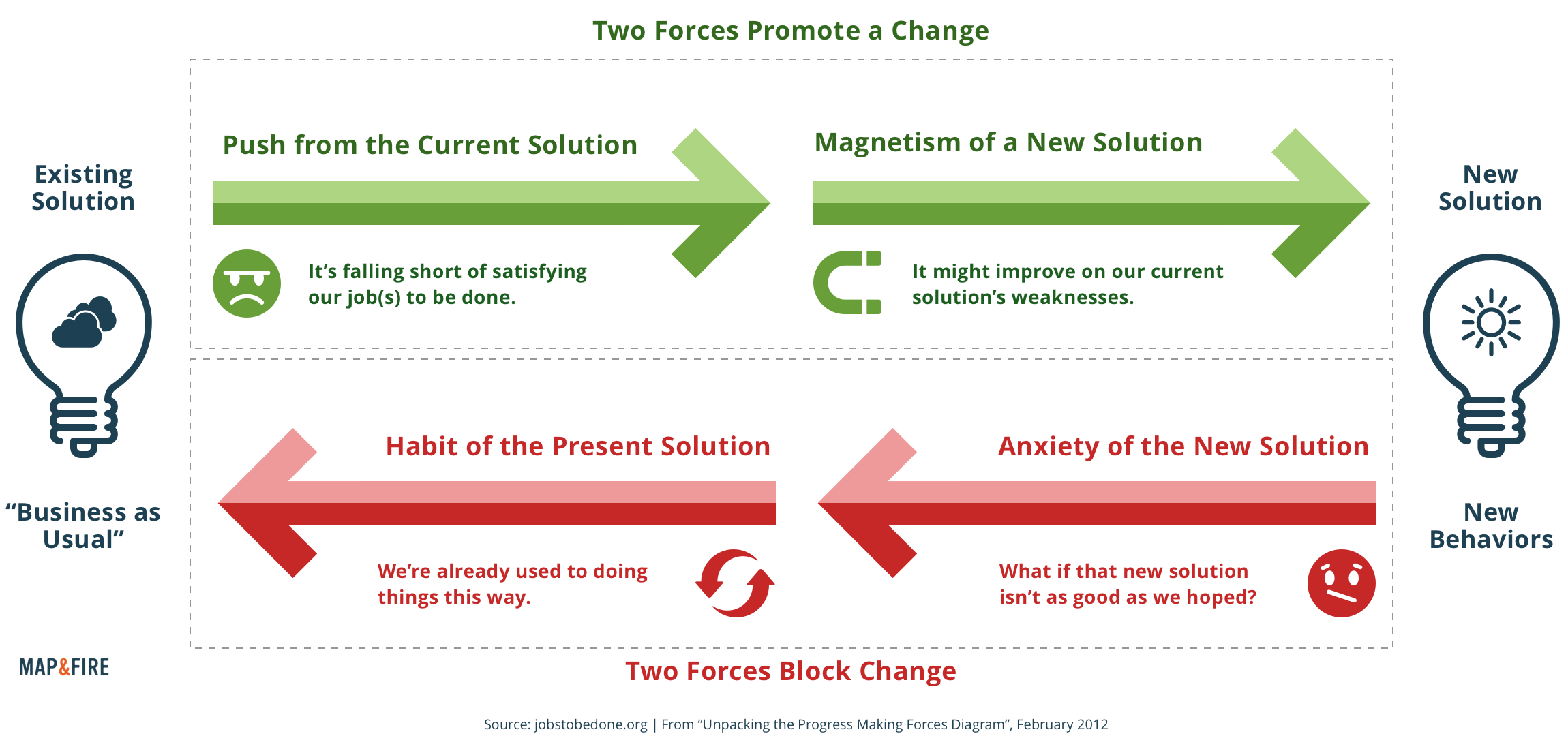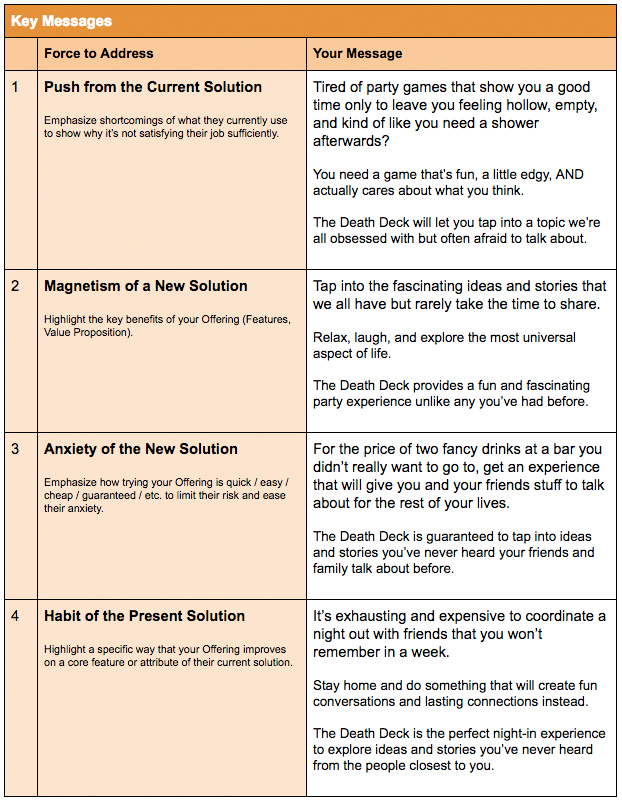
This series follows a real life startup to show how you can craft the strategy and messaging you need to launch your business idea and validate it with customers.
Quick Recap and Context
If you’re just jumping in, this series is designed to walk through a process to define the strategy and messaging for your business using the real life case study of a party game called The Death Deck. If you haven’t read that intro, it would be good to check that out first to get some context:
Read the intro to the series and the origin story of The Death Deck.
The steps being covered in this series are:
- Your Vision
- Your Target Customers’ Jobs
- Your Competition
- Your Offering and Its Features
- Your Tone of Voice and Messaging [You Are Here!]
If you’re all caught up and ready for the final step, let’s go!
Note: This final step actually has two parts: Tone of Voice and Messaging. We’ll start with Tone of Voice.
Step 5a: Your Brand’s Tone of Voice
This step will help you define:
- The emotional quality of how you communicate
- A set of dimensions and words to guide your communications and keep them consistent
Why it’s important:
In order to build trust with your customers, they’ll need to read and hear messaging that’s clear and consistent. It also needs to align with the expectations they have when looking for the type of offerings you provide.

If you think about your own experiences, you have different expectations when you’re engaging with a bank versus a fast food chain. If the business doesn’t speak to you with an appropriate tone for that setting, you’re unlikely to trust what they’re offering.
This is a key part of building authenticity in your brand. It’s not about how you personally like to communicate, it’s about what your customers like and expect within the context of the problem you’re solving for them.
Exercise: Tone Dimensions
The first part of the Tone exercise involves choosing a position on four sets of opposite words.
For each of the four word pairings below, place an “X” in the box that best corresponds to the Tone you desire for your business.
Here’s what the selections look like for The Death Deck.

Highlight 4–6 words that describe your desired tone well.
Strikethrough up to 6 words that do not describe your desired tone.
Here are the Key Words for The Death Deck.

(The material for the exercises was adapted from research conducted by the Nielsen Norman Group. They explain the approach of their research in the articles: The Four Dimensions of Tone of Voice, and Tone of Voice Words.)
Key Takeaways:
Remember that this exercise isn’t about personal style or preferences, it’s about defining a tone that’s aimed at connecting with your customers. It needs to fit within the expectations they have around the Job you’re seeking to satisfy.
It would be easy to assume that because The Death Deck operates in the space of death and dying that it would have a tone that’s hedges more serious and formal. Those are the types of attitudes we typically associate with that topic.
But The Death Deck is a game, and the core Job it’s satisfying for its customers is “spending quality time with friends and family”. That’s an environment where people want to have fun and share stories. To do that, they need to be comfortable and enjoy themselves. The Death Deck, in turn, has to create an experience that’s conducive to those feelings.
Step 5b: Your Messaging
This step will help you define:
- How the psychological forces that promote or block change in a person’s life may impact their desire to engage with your offering
- Different ways to describe the unique factors of your offering to emphasize or overcome those forces
Why it’s important:
At last, the messages! The previous exercises were all helping to contribute the ingredients you need for effective messaging:
- Vision: What ultimate goal or state are we leading our customers to achieve
- Customers: What Job are we focusing on and what do our customers value about it
- Competition: Who else is satisfying that Job and how are they doing it better / worse / differently
- Offering: What are the specifics elements of what we’re doing to satisfy that Job
- Tone: What’s the most effective way to speak to our customers about this Job
It’s easy to see how if you were to jump straight to writing messages, you’d have a pretty difficult time coming up with effective ideas around how to communicate. By thinking through these different areas of your business, it clarifies what you’re providing your customers so you can make deliberate choices around how to best connect with them.
This step will help you channel all those ingredients into messages that tell your customers why your offering satisfies their needs.

Exercise: Writing Key Messages
Taking into account all the elements you’ve defined so far, write four Key Messages, each of which focuses on one of the forces that affect your customer’s desire to engage with your offering.
Focus on the benefits your customers will receive from your offering, not just the features of it.
In each case you’ll want to write a message that either emphasizes the positive element of the force, or counteracts the negative elements of the force:

(The material for this exercise was adapted from The ReWired Group🙂
Here are some examples for The Death Deck:

Key Takeaways:
Looking at these different options you start to see how many different angles there are to present the same concept. Some options focus first on competitive differences, others on cost and convenience, and others on the unique experience being provided.
One important unifying factor though is that they all speak to the Job of the customers and highlight how this solution satisfies what they need.
Another important factor is that they speak not to the features of the game, but to the benefits the customers will receive by playing.
There will always be a creative element to crafting good messaging, but by going through this process you’ll have the right data and parameters to hone that creativity and put it to good use.
Yes, I’ve got my new messaging! What do I do now?…
Now is the really fun part. You get to test out your direction with your customers!
Throughout this process you made lots of assumptions about what your customers want and what they value. Getting your message in front of real customers is how you’ll test those assumptions and prove out whether your strategy is effective.
The best way to test assumptions is through experiments. To learn more about that process you can read this article and use our experiment template.
To start your experimentation process, use your messaging to get customers to take an action on your website. This action could be providing their email address to learn more, pre-order your product, or share your site on social media.
Check out the website for The Death Deck to get some ideas of what these elements look like in action.
If you don’t have a website yet, there are plenty of tools out there to make it easy. The Death Deck site is built using WordPress, but services like Squarespace or Wix can work as a great first step.
Once your site is set up, try driving some people to it with Facebook ads (here’s a great how-to guide to get you started!). You can use your new messaging on your website and your ads.
With a tiny budget and a little elbow grease, there are lots of cheap and easy ways to see if your messaging resonates with your customers.
And when it doesn’t work right away (don’t worry, it almost never works the first time), you’ll now have all the materials and process you need to refine and improve your message until it hits the sweet spot with your target audience.
Need Help?
If you ever get stuck on any of these steps you can get more free resources in our Field Guide.
And if you want help from us personally, you can reach out for a free consultation any time.
If you just want free stuff to help you think about your business in new ways sent to your inbox, sign up below!


